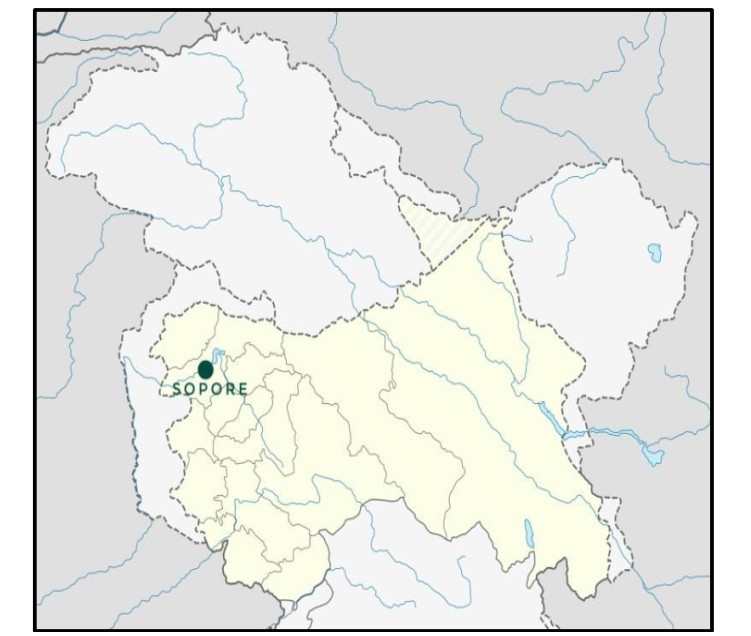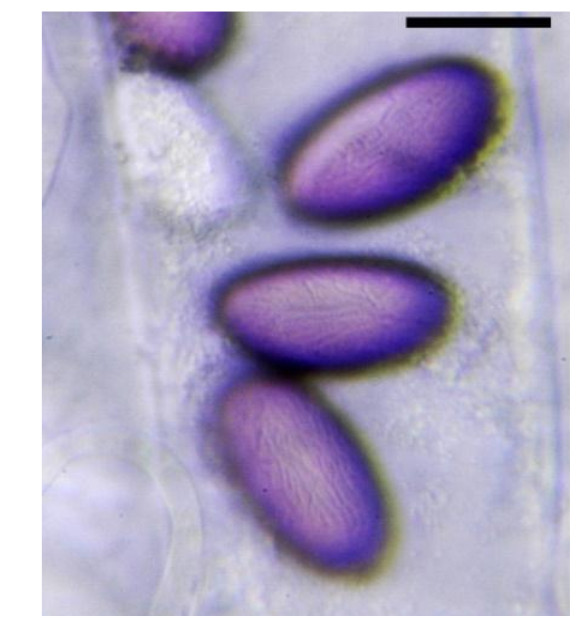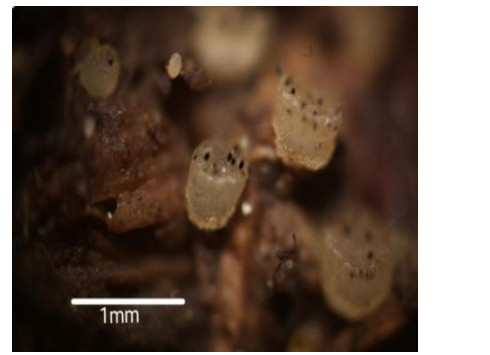HTML
-
The family Ascobolaceae Boud. ex Sacc. of class Ascomycetes is comprised of 6 genera and about 129 species which are primarily saprobic species associated with herbivore dung (Kirk et al. 2008) or plant debris. The family Ascobolaceae is characterized by operculate asci and very thick walled uninucleate ascospores, which are hyaline when immature but become colored at maturity before discharge. Pezizoid ascomata, protruding asci from the hymenium, and colored episporium are the distinguishing characters of this family that make it different from the rest of Ascomycetes (Van Brummelen 1967). Ascobolus and Saccobolus are the most common genera of this family, and are some of the best-known coprophilous species of fungi.
The genus Ascobolus was first established by Gmelin in 1792, which is characterized by their mutually free ascospores inside the asci. The genus Saccobolus is comprised of about 25 species (Kirk et al. 2008) and is characterized by apotheciod ascomata, clustered ascospores which are usually arranged in clusters of a regular pattern within a common gelatinous membrane (Van Brummelen 1967) and by showing brown or purple brownish episporic pigment upon maturation (Van Brummelen 1967, Kaushal & Virdi 1986, Doveri 2004, Bell 2005). The ascospores of Saccobolus are similar to those of Ascobolus but are differentiated from the latter by their clustered arrangement and their shorter but broader asci and ascospores shapes (Van Brummelen 1967, Doveri 2004, Bell 2005).
Van Brummelen (1967) published the first monograph of the genera Ascobolus and Saccobolus, which also included four species from India. To date, about 15 species of Ascobolus and 7 species of Saccobolus have been reported from India by various researchers in this field. (Tables 1, 2).
Table 1. List of Ascobolus speciesreported from India
No. Species Name Place of collection from India References 1 A.behnitziensis Kolhapur, Maharashtra Ghandge & Patil (1988) 2 A.brassicae** Varansi, Uttar Pradesh Khare (1976) 3 A.crenulatus Satara, Maharashtra Ghandge & Patil (1988) 4 A.denudatus Narkanda, MahasuUttarakhand Thind & Waraitch (1974) 5 A.foliicola** Radhanagari, Maharashtra Ghandge & Patil (1988) 6 A.furfuraceus** India, place not mentioned Van Brummelen (1967) 7 A.geophilus Mussoorie hills, Uttarakhand Ghandge & Patil (1988) 8 A.gollanii Saharanpur garden, Uttar Pradesh Hennings (1901) 9 A.hawaiiensis Kolhapur, Maharashtra Ghandge & Patil (1988) 10 A.immersus Patna Ghandge & Patil (1988) 11 A.indicus Delhi Sanwal (1953) 12 A.minutus Karad Maharashtra Ghandge & Patil (1988) 13 A.sacchariferus** Kolhapur, Maharashtra Ghandge & Patil (1988) 14 A.scatigenus Sheikhupura Van Brummelen (1967) Dalhousie, Punjab Van Brummelen (1967) Hyderabad, Punjab and Uttar Pradesh Leelavathy & Flower (1981) Hyderabad Van Brummelen (1967) Saharanpur Graden, Uttar Pradesh Van Brummelen (1967) 15 A.gomayapriya Andaman Islands Niranjan & Sarma (2018) Table 2. List of Saccobolus species reported from India
No. Species Name Place of collection from India References 1 S. diffusus Kasauli, Himachal Pradesh Kaushal & Virdi 1986 2 S. glaber** Hyderabad Van Brummelen (1967) 3 S. humidicola Kasauli, Himachal Pradesh Kaushal & Virdi 1986 4 S. saccoboloides Kasauli, Himachal Pradesh Kaushal & Virdi 1986 5 S. thaxteri Patiala, Punjab Kaushal & Virdi 1986 6 S. versicolor Kasauli, Himachal Pradesh Kaushal & Virdi 1986 7 S. verrucisporus Kasauli, Himachal Pradesh Kaushal & Virdi 1986 8 S. depauperatus* Sopore, Kashmir Present study *First report from India
**First report from KashmirThe main objective of this study is to report six species new to Kashmir, India viz A. brassicae, A. furfuraceus, A. foliicola, A. saccharifereus, Saccobolus depauperatus and S. glaber of genera Ascobolus and Saccobolus as well as to provide checklist of species of genera Ascobolusand Saccobolus species reported from India to date. The knowledge of these genera in India is very limited, and family Ascobolaceae has not been researched sufficiently in this part of the world.
-
The study area, Kashmir has not been surveyed extensively for fungi, so various field trips were made to study its biodiversity. While doing so, some specimens from family Ascobolaceae were collected in the year 2019. Fresh specimens were collected in vials and then rehydrated in a damp/moist chamber to extend their life and allow us to regrow them. These specimens, along with their respective substrates were kept in a plastic box lined with wet tissue paper to retain moisture. The specimens were brought to the laboratory for further investigation. Specimens were air dried, at temperature less than 40℃, in a shady area to prevent any damage to them and were then deposited along with substrates in the herbarium of Government Degree College Sopore. Micro-slides were prepared either by making freehand sections of the specimens (In case of larger specimens viz A. foliicola, A. furfuraceus and A. sacchariferus), or by making a crush mount. Fresh/live material was examined under a Labomed CXL, mounted in sterile water. For the amyloidity test Lugol's Iodine (Baral's recepie) as well as Melzer's reagent were used separately, due to the fact that, although Lugol's Iodine is preferred for Ascomycetes (Baral 1987, Melzer's reagent was preferred by Van Brummelen (1967). Measurements were taken manually using an ocular micrometer calibrated with a stage micrometer. At least thirty mature spores from each specimen, all with well-developed episporium, were measured to minimize the error.
The literature of Van Brummelen (1967), Kaushal & Virdi (1986) and Doveri (2014) were used for species identification. Facesoffungi numbers were registered as per Jayasiri et al. (2015). The first author Suhaib Firdous Yatoo has the copyright of all the photographs.
-
Ascobolus brassicae P. Crouan & H. Crouan, Ann. Sci. nat., Bot., ser. IV, 7:174 (1857) Fig. 2

Figure 2. Ascobolus brassicae. a Ascomata on rodent dropping. b Asci showing mature and immature spores. c Ectal excipulum. d Paraphyses. e Spores. Scale bars: a = 100 µm, b, d, e = 20 µm, c = 10µm.
Index Fungorum number: IF 245343; Facesoffungi number: 10090
Description - Apothecia gregarious, 0.3-0.7mm in diameter, up to 0.3 mm in height, white at first, later becoming light pink due to protruding pink asci, margin furfuraceus. Asci cylindrical to clavate, with distinct large operculum, 140-160×22-28 µm, biserate packed spores. Paraphyses cylindrical branched with irregularly shaped tips, without pigment, 140-160×3-5 µm. Excipulum of textura globulosa, 15-40µm. Spores globose, distinctly warty, episporium light pink, 12.8-13.4µm.
Note - A rarely collected species from India, with only one record and representative collection, reported from Uttar Pradesh (Khare 1976). Niranjan & Sarma (2018) (A. gomayapriyaspp. nov.) reported 13 species in India, with A. brassicae not being mentioned, perhaps by mistake.
Material Examined - India, Jammu and Kashmir, Sopore, Nowpora kalan, on rodent droppings, 1 Jul 2020, Suhaib Yatoo, GDC-BOT-030720 (Govt. Degree college Sopore), GDC-BOT-250220, 34.2926300, 74.4402760, 22.02.2020.
Ascobolus foliicola Berk. & Broome in J. Linn.Soc. (Bot.), Lond.14: 109 (1873) Fig. 3
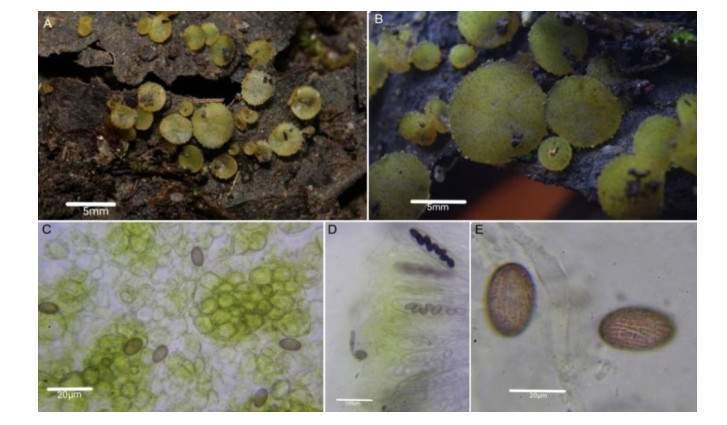
Figure 3. Ascobolus foliicola. a, b Ascomata. c Ectal excipulum. d Asci with biserate arrangement of spores and paraphyses. e Spores. Scale bars: a, b = 5mm, c, d, e = 20 µm.
Index Fungorum number: IF 144172; Facesoffungi number: 10089
Description - Apothecia gregarious, stalked, yellow in color, upto 8mm in diameter, 0.5 mm in height, margin furfuraceus. Hymenium 180- 210 µm. Hypothecium well developed, cells up to 6- 10µm in diameter. Asci cylindrical, 180 - 220µm, spores uniserate earlier later on becoming biserate. Paraphyses cylindrical, branched at tips, yellow pigmented. Excipulum with pyriform- subglobose cells, 10-30 µm×15-60 µm. Spores with pink-brown episporium. Episporium with anastomosing ridges becoming reticulate in later stages. Spore size variable 15.5-22µm×7.5-12.7µm, depending on the stage of maturation, exospore swollen in mature spores.
Material Examined - India, Jammu and Kashmir, Sopore, Nowpora kalan, on dead and rotten Populous deltoides leaves, 01 Jul 2020, Suhaib Yatoo, GDC-BOT-030720 (Govt. Degree college Sopore), 34.2926300, 74.4402760, 01.07.2020.
Ascobolus furfuraceus Pers., Neues Mag. Bot. 1: 115 (1794) Fig. 4
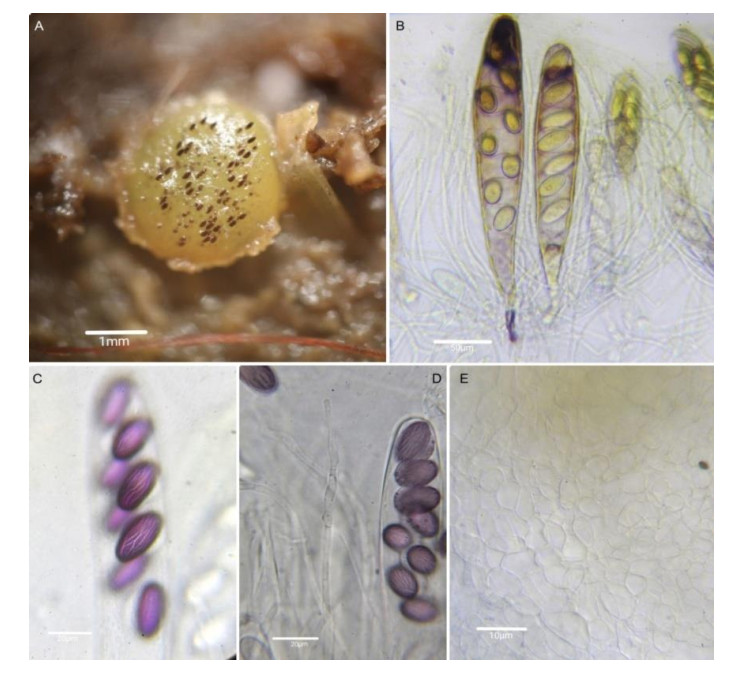
Figure 4. Ascobolus furfuraceus a Ascomata. b Asci in Lugol's solution. c Asci with biserrate arrangemet of spores. d Paraphyses. e Excipulum. a = 1mm, b= 50µm, c, d = 20µm, e = 10µm.
Index Fungorum number: IF 143631; Facesoffungi number: 10094
Description - Apothecia gregarious or solitary, sessile, 1-5mm in diam., 0.5-1mm high, closed subglobular at first, later becoming flat to concave disc shaped, lemon-yellow with pink protruding asci at first and becoming brown in final stages, with well-developed furfuraceus margin. Hymenium, 180-220µm, flesh including the hypothecium of isodiametric cells up to 10-15um in diameter. Excipulum made of globular to sub globular cells up to 10-60µm, margins with thick-walled pyriform cells upto 50-80 × 30-60µm. Asci clavate (120-)170-240µm × (20-)25-35µm, 8-spored, with uniserate spore arrangement in early stages and biserate in later stages, light blue in Lugol's reagent. Spores ellipsoid, hyaline at first, then pinkish, finally purple-brown, 20-29×10-14µm, ornamented with longitudinal, often anastomosing, striations. Paraphyses simple, rarely branched, enclosed within a lemon-yellow mucilage.
Material Examined - India, Jammu and Kashmir, Sopore, Nowpora kalan, on cow dung, 12 May 2020, Suhaib Yatoo, GDC-BOT-130520 (Govt. Degree college Sopore), 34.2932942, 74.4394454, 09.05.2020.
Ascobolus sacchariferus Brumm., Persoonia suppl. vol. 1: 122 (1967) Fig. 5
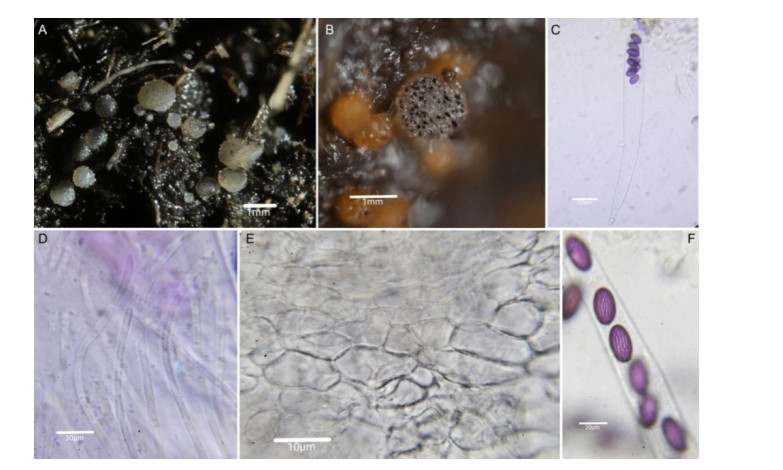
Figure 5. Ascobolus sacchariferus. a, b Ascomata, c ascus with spores. d Paraphyses. e Ectal excipulum. Scale bars: a, b = 1 mm, c, e = 20 µm, d = 10 µm.
Index Fungorum number: IF 326522; Facesoffungi number: 10093
Description - Apothecia solitary or gregarious, sessile, 0.8-3mm in diam., 0.5-1mm high, finely furfuraceus, with a distinct margin, apothecia initially globular and white, later becoming hemispherical and purplish-brown due to maturation of ascospores. Hymenium up to 180µm thick, hypothecium of round cells up to 9 µm in diameter. Excipulum of textura-globulosa (up to 10µm) at the base but becoming textura-angularis (12-50µm×15-20µm) towards the margin. Asci 8-spored, narrowly clavate with uniserate spore arrangement which later on becoming biserate, 180-220×15- 20µm, with curved base, slightly blue in Lugol's reagent, spores 18-21×8.5-11.2µm.
Material Examined - India, Jammu and Kashmir, Sopore, Nowpora kalan, on cow dung and horse dung, 02 Mar 2020, Suhaib Yatoo, GDC-BOT-040320 (Govt. Degree college Sopore), 34.2877819, 74.4397236, 02.03.2020.
Notes - Variation in spore ornamentation was observed in one out of thirty specimens cultured in moist chamber. Episporium reticulated without deep crevices (Fig. 6), no more variations were observed.
Saccobolus glaber (Pers.) Lambotte, Fl. Mycol. Belg., suppl. 1: 284 (1887) Fig. 7
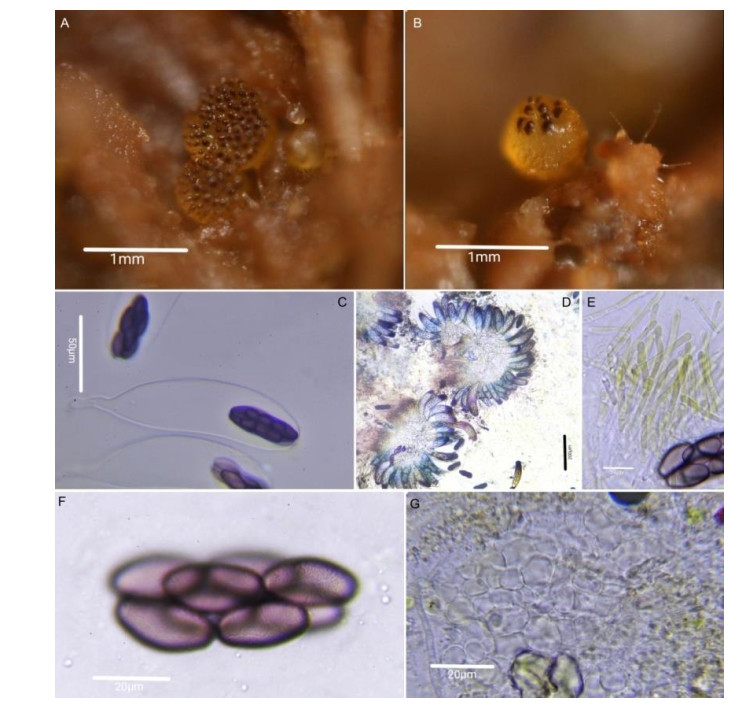
Figure 7. Saccobolus glaber. a, b Ascomata. c Asci with spore clusters. d Squashed ascoma in Lugol's. e Pigmented Paraphyses. f Ascospores. g Excipulum. Scale bars: a, b = 1mm, c = 50 µm, d, f, g = 20 µm, e = 30 µm.
Index Fungorum number: IF 120544; Facesoffungi number: 10092
Description - Apothecia solitary to gregarious, sessile, concave, 0.3-1mm in diam., yellow at first, amber in later stages, margin undifferentiated. Hymenium 120-200µm thick, hypothecium poorly developed, flesh made of thin-walled isodiametric cells 10-15µm in diameter. Excipulum of globular to sub globular cells 10-18 µm×9-15 µm. Asci broadly clavate with a tapering short stalk, 150-240 × 30-45µm, tip flattened containing a large operculum, 8-spored, wall deep-blue to purple in Lugol's reagent. Spores clustered within a common gelatinous envelope according to pattern-I (Van Brummelen 1967), each spore 20-30×10-15µm, slightly to strongly punctate. Paraphyses simple, unbranched with slightly swollen tips upto 9µm, containing yellow pigment in the upper part, enclosed within a colorless mucilage.
Material Examined - India, Jammu and Kashmir, Sopore, Nowpora kalan, on cow dung, sheep and goat droppings, 26 Feb 2020, Suhaib Yatoo, GDC-BOT-280220 (Govt. Degree college Sopore) 34.2916666, 74.4426312, 22.02.2020.
Note - White fruiting bodies (Fig. 8) were also observed, mostly found among the populations with adequate pigment but usually on the substrates that were exposed to direct sunlight. Upon re-growing in the moist chamber, they developed the normal pigmented fruiting bodies, suggesting that the variation was environmental.
Saccobolus depauperatus Berk. & Broome., Ann. Mag. Nat. Hist. III 15: 448 (1865) Fig. 9

Figure 9. Saccobolus depauperatus.a, b Ascomata. c Squashed ascoma in Lugol's. d Spore arrangement and shape of common mucilage. Scale bars: a-c = 150 µm, d = 20 µm
Index Fungorum number: IF 148254; Facesoffungi number: 10091
Description - Apothecia solitary, sessile, convex, 0.1-0.5 mm in diam., white at first, pink to purple in later stages, margin undifferentiated. Hymenium 70-120 µm thick, hypothecium poorly developed, flesh made of thin-walled isodiametric cells 10-15µm in diameter. Excipulum very thin, made of isodiametric cells (textura globulosa). Asci broadly clavate with a tapering short stalk, 70- 90 × 20-24 µm, tip flattened containing a large operculum, 8-spored, wall deep-blue to purple in Lugol's reagent. Spores clustered within a common gelatinous kidney shaped envelope according to pattern-II (Van Brummelen 1967), each spore 20-30×10-15µm, slightly to strongly punctuate with slight grayish tinge. Paraphyses cylindrical, lacking amorphous pigment.
Material Examined - India, Jammu and Kashmir, Sopore, Nowpora kalan, on horse dung (in moist chamber), 06 Mar 2020, Suhaib Yatoo, GDC-BOT-080320 (Govt. Degree College Sopore), 34.2916666, 74.4426312, 05.03.2020.
Note - Very small apothecia were preserved in Hoyer's medium (although episporium coloration and other structures are preserved, spores show a slight difference in size).
-
Kashmir is a fertile basin in India bordered by the Himalayas in the north and is one of the 26 biodiversity hotspots in India. Kashmir is one of the least explored biodiversity rich regions explored in India. The family Ascobolaceae mostly includes coprophilous fungi and is well represented by genera Ascobolus and Saccobolus. Both genera are closely related and differ mainly in their arrangement of ascospores within the asci.
The study provides the description of six species within genera Ascobolus and Saccobolus viz Ascobolus brassicae, A. furfuraceus, A. foliicola, A. saccharifereus, Saccobolus depauperatus and S. glaber with photomicrographs. A checklist of species of these genera reported from India to date is also provided. Ascobolaceae is represented by 6 genera and 129 species, although only 15 species of Ascobolus and 7 species of Saccobolus have been described from India. The present study is the first report of all described species from Kashmir, and the first report of S. depauperatus from India as a whole.
Some morphological variations were noted during the study, such as the spore ornamentation in some specimens of Ascobolus sacchariferus, however no other deviations from A. sacchariferus were noticed, so the specimens are considered just a variant to the typical A. sacchariferus. In addition, variations in fruiting body coloration in the Saccobolus glaber specimens were also observed. However, on regrowing the specimens in a moist chamber, no such variations presented, suggesting that the variable colorations completely environmental.
The present work contributes to knowledge of the family Ascobolaceae of India, increases knowledge about the genera Ascobolus and Saccobolus, and will help the researchers in this field to better understand their biology and distribution.
-
We are highly thankful to Mr. Björn Wergen (Germany) and Mr. François Valade (France) for helping us identify these species and for providing literature. We are also highly thankful to Mr. Amir Maqbool.
- Copyright: © 2021 by the author(s). This article is an open access article distributed under Creative Commons Attribution License (CC BY 4.0), visit https://creativecommons.org/licenses/by/4.0/.
| SF Yatoo, PV Phate, TA Wani. 2021. Contributions to the family Ascobolaceae of India. Studies in Fungi 6(1):263−272 doi: 10.5943/sif/6/1/17 |












